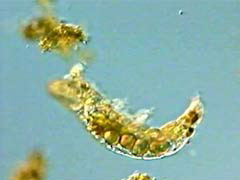
Echiniscus Video #1
This amber colored water bear moves in and out of the focal plane, its stubby legs trying to get a more secure footing; under DIC illumination at a magnification of 100x with a playing time of 40.2 seconds. Choose a playback format that matches your connection speed:
This genus of water bear is widespread and common. Their bodies are short, plump, and contain four pairs of limbs that are poorly articulated, a characteristic typical of soft-bodied animals. Each limb terminates in four to eight claws or discs. They lumber about in a slow bear-like gait over grains of sand and dirt or pieces of vegetation.
Approximately 350 species of the phylum Tardigrada (slow-walking animals) are known to occur worldwide. Also called water bears, most of these free living organisms are one millimeter or less in size and live in a wide variety of habitats: in damp moss, on flowering plants, in sand, in freshwater, and in the sea. Most water bears feed on the fluids of plant and animal cells, but a few are predatory carnivores. They are dioecious, having both male and female members, but the sexes are not distinct. One of the unique traits of water bears, and an obvious key to their survival, is their ability to reversibly suspend their metabolism, a condition called cryptobiosis.